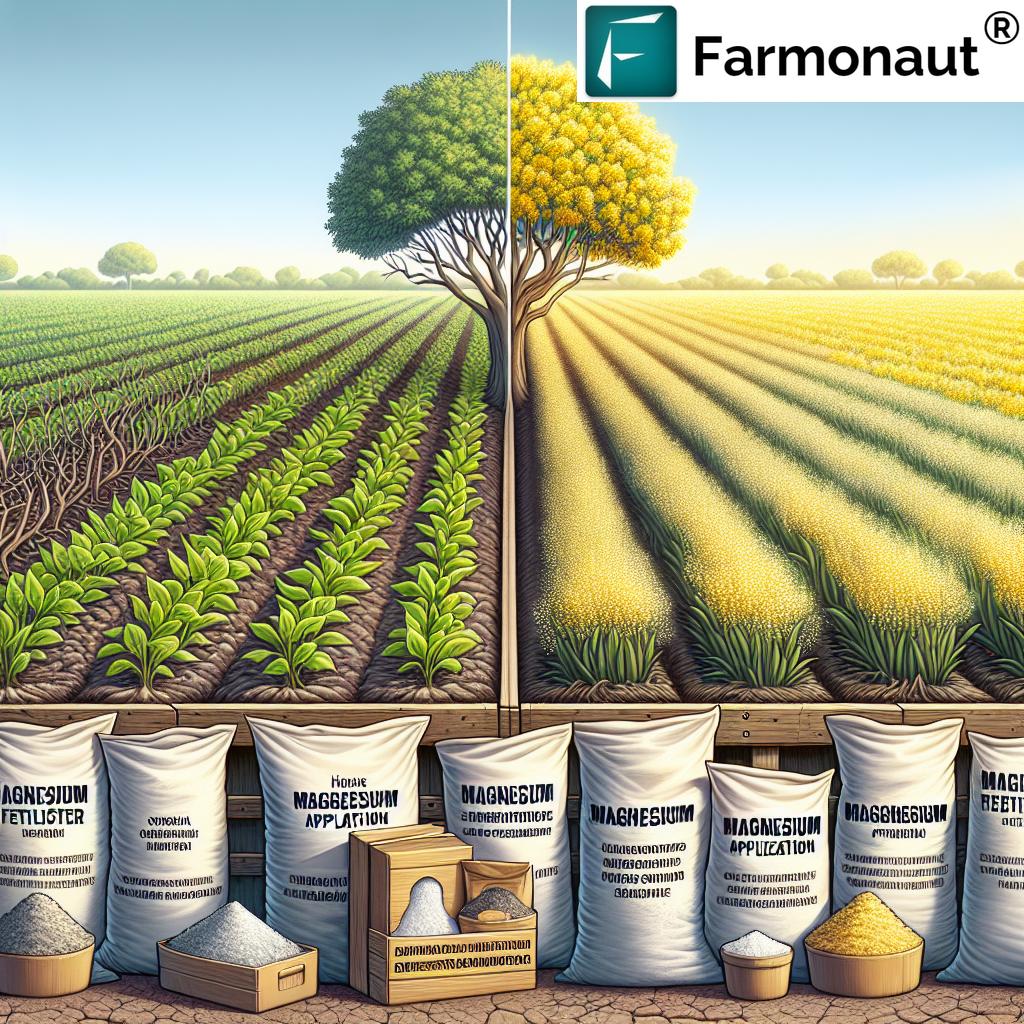Magnesium Deficiency in Plants: 7 Shocking Fixes!
“Magnesium deficiency can reduce crop yields by up to 30%, severely impacting sustainable agriculture and food security.”
Introduction: Why Magnesium Matters for Plant Health
Within the world of sustainable agriculture, magnesium (Mg) stands out as an essential macronutrient that often gets overlooked—until deficiencies arise that threaten crop yield, soil health, and ecosystem balance. As the central atom in the chlorophyll molecule, magnesium is absolutely vital for photosynthesis, enzyme activation, and energy transfer. Its absence or shortage can trigger a cascade of physiological issues in plants, resulting in classic symptoms of magnesium deficiency such as interveinal leaf yellowing, stunted growth, and even significant agricultural losses.
In this comprehensive guide, we will explore and demystify magnesium deficiency in plants. We’ll investigate its causes, and symptoms, and reveal seven game-changing, sustainable fixes. We’ll also demonstrate how precision agriculture technologies, such as those from Farmonaut, empower farmers to manage magnesium nutrition for healthier crops and a greener future.
“Over 60% of soils worldwide are magnesium-deficient, threatening global efforts toward sustainable farming and healthy ecosystems.”
Understanding Magnesium Deficiency in Plants
Let’s start with the fundamentals—what is magnesium deficiency in plants? Magnesium plays a pivotal role in plant nutrition due to its central function in:
- Chlorophyll Synthesis: Magnesium is the core atom in chlorophyll, making it indispensable for capturing sunlight during photosynthesis.
- Enzyme Activation: Over 300 plant enzymes depend on magnesium, influencing key physiological processes such as protein synthesis, metabolite transport, and hormone activation.
- Energy Transfer: Magnesium aids ATP production and movement throughout the plant, powering growth and development.
When magnesium is lacking, these processes begin to falter. The most visible result? Plant stress, nutrient imbalances, and major threats to agricultural yield and quality. Recognizing and managing magnesium deficiency is therefore critical for both sustainable farming practices and long-term soil health.
Causes of Magnesium Deficiency
Magnesium deficiency may appear suddenly, but its roots often stretch deep. To implement effective magnesium management strategies, we must first understand the underlying causes and the way certain farming practices inadvertently make the problem worse.
Key Factors That Lead to Magnesium Deficiency in Plants
-
Acidic & Coarse Soils Prone to Leaching
Soil composition plays a major role. Acidic (low pH) soils and light, sandy textures are particularly vulnerable, allowing magnesium to leach away easily with excessive rainfall or irrigation, reducing available magnesium levels in critical root zones. -
High Calcium and Potassium Fertilization
Calcium and magnesium compete for absorption sites within plants. Similarly, excessive potassium application in intensive fertilization regimes can induce magnesium deficiency by outcompeting magnesium during root uptake. The result? Healthy soils become imbalanced, and magnesium uptake in crops declines—even when total magnesium content isn’t initially low. -
Intensive Cropping Systems Without Nutrient Replenishment
Continuous cropping (growing crops back-to-back without adequate replenishment of magnesium and other essential nutrients) quickly depletes soil reserves. Over time, this practice can lead to chronic magnesium deficits, especially where harvested crops are removed but nutrients aren’t replaced. -
Unbalanced Fertilizer Practices & Excessive Inputs
Using fertilizers without balancing nutrient ratios—or adding high levels of one nutrient—can hinder uptake of magnesium. For instance, potassium and calcium must be managed relative to soil magnesium levels to maintain plant health.
In summary: The interplay of soil pH, texture, excessive calcium or potassium, and nutrient-depleting cropping systems makes careful monitoring and management of soil magnesium levels as important as any other practice in modern agriculture.
Symptoms of Magnesium Deficiency in Plants
Identifying magnesium deficiency in plants early can save entire harvests. Magnesium is a mobile nutrient—meaning plants move it from older to younger tissues in times of shortage, so symptoms first appear on older leaves. Here’s what to watch for:
- Interveinal Chlorosis: The classic sign. Leaves develop yellowing between the veins, but the veins themselves remain green. This symptom, known as interveinal chlorosis, is typically obvious on older leaves.
- Necrosis: As the deficiency progresses, affected leaf areas may develop necrotic spots—that is, areas of dead tissue—sometimes leading to premature leaf drop.
- Stunted Growth & Poor Yield: Magnesium deficiency stunts plant growth. Affected plants are often shorter, with fewer and smaller leaves, and they typically produce lower overall yields.
- Leaf Curling: Older leaves may curl upward or downward, and the edges can become brittle or scorched-looking.
- Pale Yellow Foliage: In grains like barley, foliage becomes pale yellow, thinning and losing vigor. In severe cases, necrotic lesions appear, especially as plants approach maturity.
If you notice these symptoms, it’s crucial to test your soil magnesium levels as soon as possible, so you can take timely corrective action.
Effects of Low Magnesium on Plants & Crop Yield
Now that we can spot magnesium deficiency in our crops, we must realize its full impact. Insufficient magnesium is not just a cosmetic issue—it fundamentally affects crop physiology, photosynthesis, energy transfer, and overall plant health. That’s why magnesium for crop yield and sustainable soil management is essential across food production systems.
How Crops Respond to Magnesium Deficiency
- Sugar Beet: Deficiency frequently shows in mid to late season (from July onwards), with leaf magnesium dropping to 0.10–0.15% dry matter. Yield drops of up to 2 tons per hectare have been reported from uncorrected deficiency.
- Potatoes: Interveinal yellowing on older leaves is common. Yields and tuber quality decrease significantly if magnesium remains below 0.15% dry matter at flowering.
- Barley: Young plants show poor, stunted growth and pale leaves. Later, mature barley can develop thin stems, necrotic lesions, and severe yield reduction.
Beyond these, nearly all crop species are affected by insufficient magnesium. The result is simultaneous risks to yield, soil health, and the sustainability of farming practices around the world.
For larger farms and institutional clients, Farmonaut’s Large Scale Farm Management Platform offers integrated real-time crop health and soil analytics, ensuring timely, large-area detection of nutrient imbalances like magnesium deficiency, reducing costs and optimizing yield.
Magnesium Deficiency in Plants: 7 Shocking Sustainable Fixes
The good news? With a combination of advanced technology and smart nutrient management practices, we can tackle magnesium deficiency in plants directly, securing healthy yields and fostering sustainable systems. Here are seven high-impact, proven solutions:
1. Soil Testing and Monitoring for Targeted Magnesium Management
- The first step to managing any deficiency is knowing your soil magnesium levels. Through regular soil testing, we can detect shortages before they manifest as visible symptoms.
- Satellite-powered solutions like the Farmonaut Platform use multispectral imagery and smart analytics for real-time crop health monitoring, allowing us to spot plant stress and potential magnesium deficiency zones across entire fields.
- Detailed data enable granular, site-specific interventions, reducing waste and resource usage.
Explore satellite-powered magnesium monitoring with Farmonaut’s API, or integrate crop health data through the Developer API Docs.
2. Balanced Magnesium Fertilizer Application
- Applying magnesium-containing fertilizers like magnesium sulfate (Epsom salt), dolomite limestone, or kieserite is proven to restore soil magnesium and correct existing deficiencies.
- Foliar sprays provide a rapid response (particularly useful for sensitive or high-value crops), while soil applications ensure long-term nutrition.
- Adjust rates according to crop species, soil texture, and soil test results for optimal efficiency.
3. Organic Amendments to Improve Soil Magnesium
- Incorporating organic matter (such as compost or well-rotted manure) is among the best sustainable solutions. These amendments improve soil structure, organic matter content, and magnesium retention.
- They foster a healthy soil microbiome, enhance nutrient cycling, and provide a slow-release source of magnesium.
Boost soil health and carbon sequestration by leveraging Farmonaut’s Carbon Footprint Tracking Tool. It allows growers to monitor and reduce emissions when transitioning to organic soil management.
4. Adjusting Fertilizer Practices to Prevent Uptake Issues
- Balance calcium and potassium applications with soil magnesium levels to avoid competitive inhibition during root absorption.
- Split fertilizer applications in high-rainfall or irrigated systems can help reduce leaching and maximize uptake.
- Optimize fertilizer timing and technique to target critical growth stages when magnesium demand peaks.
5. Managing Soil pH for Maximum Magnesium Availability
- Soil pH is fundamental: Acidic soils limit magnesium availability even when total magnesium content is adequate.
- Applying agricultural lime (especially dolomitic lime, which contains both calcium and magnesium) can raise soil pH and simultaneously increase available magnesium.
- Carefully monitor pH and re-test after amending soil to guide future nutrient management strategies.
6. Crop Rotation and Recycling Residues
- Implement crop rotation to break up nutrient cycling bottlenecks and prevent magnesium depletion. Diverse plantings improve soil health, organic matter, and long-term sustainability.
- Returning crop residues (leaves, stems, non-harvested biomass) to the soil recycles magnesium and other nutrients, reducing the need for synthetic inputs.
- Coupled with asset and fleet management tools like the Farmonaut Fleet Management Platform, growers can ensure efficient residue recycling and field operations, enhancing productivity while lowering costs.
7. Continuous Monitoring and Adaptive Management
- Routine monitoring—via regular soil and plant tissue testing, NDVI mapping, or AI-driven farm monitoring—supports adaptive, data-driven nutrient management.
- Satellites, IoT, and AI platforms (see Farmonaut’s Crop Health Monitoring) make this achievable, scalable, and affordable—providing actionable alerts for emerging magnesium deficiency zones so interventions can be timely and site-specific.
How Farmonaut Empowers Magnesium Management
We are entering a new era of precision agriculture, and companies like Farmonaut are making it possible for every farmer—small or large—to benefit from actionable, field-specific data:
- Crop Health Monitoring: Multispectral satellite images and AI reveal crop vigor, NDVI, and possible nutrient deficiencies, such as magnesium shortages, long before they are visible to the naked eye.
- AI-Based Advisory: Jeevn AI delivers personalized, real-time crop management strategies, enabling us to improve magnesium nutrition and prevent soil health decline.
- Resource Optimization: Reduce input wastage (including magnesium fertilizers) with fleet and field management tools.
- Sustainability: Farmonaut’s carbon foot-printing facilitates environmental compliance and helps showcase sustainable improvement efforts for buyers and stakeholders.
- Blockchain Traceability: For those aiming for export or premium markets, Farmonaut’s Traceability Tool provides robust product origin data—boosting consumer trust by tracking every step of the crop’s journey, including detected and corrected magnesium deficiencies.
Access advanced tools for your farm:
Try Farmonaut’s Platform + App (Web, Android, iOS), with subscription options for every farm size below:
Symptoms, Impact & Sustainable Fixes Comparison Table
| Symptom | Est. Yield Loss (%) | Soil Health Impact | Sustainable Fix | Est. Cost Range (per acre) |
|---|---|---|---|---|
| Interveinal Chlorosis (Yellowing between green veins) | 10-15% | Mild | Foliar Spray (Epsom salt), Soil Test, Adjust K/Ca | $10 – $40 |
| Necrosis (leaf dead spots, premature drop) | 15-30% | Moderate | Magnesium-rich compost, Soil Mg application | $30 – $80 |
| Stunted Plant Growth | 10-35% | Moderate | Crop Rotation, Soil Testing, Organic Mulching | $20 – $50 |
| Leaf Curling (Older leaves, both up & down) | 5-20% | Mild | Balanced Fertilizer, Adjust Soil pH | $10 – $30 |
| Pale Yellow Foliage | 5-25% | Slight | Organic Foliar (seaweed), Mg-lime amendment | $20 – $70 |
| Reduction in Crop Quality (e.g., sugar %) | 10-20% | Moderate | Targeted Mg application, Block traceability | $20 – $100 |
| All Symptoms Present | 20-40% (Severe) | Severe | Full soil rehab, precision nutrient plan | $80 – $200+ |
FAQ: Managing Magnesium Deficiency in Plants
-
What is the fastest way to correct magnesium deficiency in crops?
The quickest response is usually foliar application of magnesium sulfate (Epsom salt). This method allows plants to absorb magnesium directly through leaves. For ongoing correction, combine with soil applications based on test results.
-
How can I improve soil magnesium levels sustainably?
Incorporate magnesium-rich organic matter (compost, manure), balance fertilizer regimes, and rotate crops to recycle nutrients. Also, keep soil pH in the optimal range (6.0–7.0) for better availability.
-
Could excessive calcium or potassium cause magnesium deficiency?
Yes, both calcium and potassium compete for uptake with magnesium in plant roots. Excessive fertilizer applications of either can lead to secondary magnesium deficiency even if soil magnesium is not inherently low.
-
How does magnesium deficiency affect sustainable agriculture?
Yield decreases, soil health declines, and more inputs are needed to compensate. This threatens both environmental and economic sustainability. Preventive measures and adaptive management are essential for sustainable production systems.
-
Why use precision agriculture solutions for magnesium deficiency?
Tools like Farmonaut deliver timely, site-specific data on crop health, soil moisture, and nutrient imbalances. This enables targeted interventions, avoiding waste and maximizing environmental sustainability.
Conclusion: Toward Sustainable Magnesium Nutrition
Magnesium is not just a supporting player in plant nutrition—it is a vital macronutrient, central to chlorophyll synthesis, enzyme activation, and energy transfer. When we understand the symptoms of magnesium deficiency, identify its root causes, and embrace both high-tech and sustainable fixes, we future-proof our fields for both productivity and environmental health.
- Regular soil and plant monitoring helps prevent deficiencies before they cause losses.
- Balanced, site-specific magnesium fertilizer application, and the use of organic soil amendments, promote long-term soil health and sustainable yield.
- Modern AgTech platforms—including Farmonaut’s real-time satellite, AI, and traceability tools—allow every grower to make informed, responsible nutrient management decisions on every acre.
For seamless, actionable crop insights that make diagnosing and correcting magnesium deficiency easier than ever, explore the Farmonaut Carbon Footprinting Tool and Crop Loan & Insurance Verification Services—helping you combine sustainable practices with robust risk management.
Remember: Smart magnesium management supports not only crop yield but also soil health, resource efficiency, and sustainable food systems—paving the way for a future where healthy plants take root on every farm.
Start Your Precision Agriculture Journey
To revolutionize your field monitoring and take magnesium nutrition to the next level—get started with Farmonaut’s web, Android, or iOS App today. For tech integrations, discover the API for Developers and empower any agritech system with next-gen soil and crop insights.


















